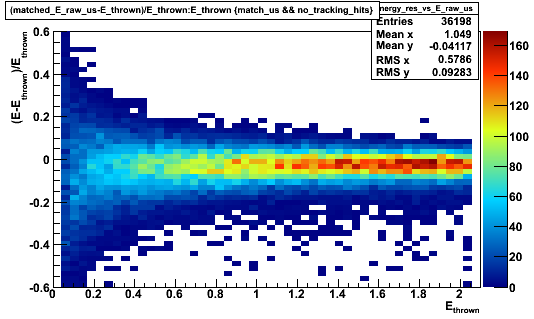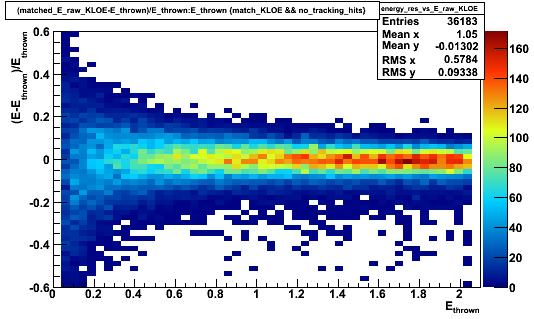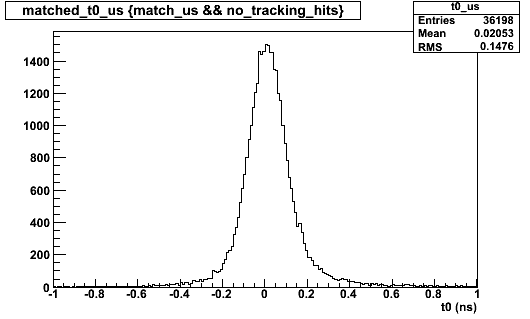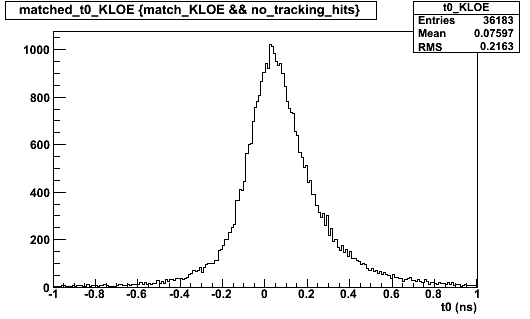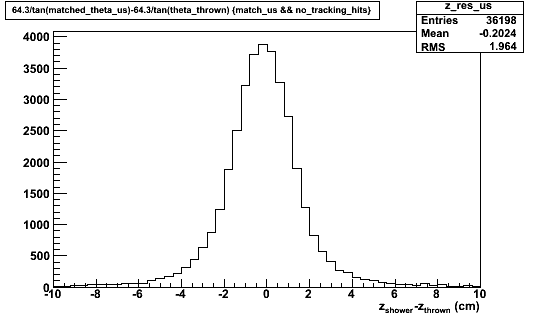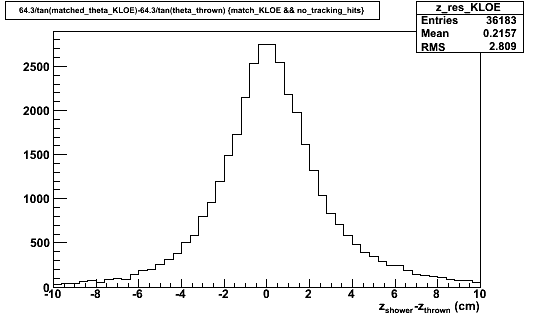BCAL reconstruction 11/28/11
Contents
Update
- 1234 segmentation now an option in reconstruction code
- New algorithm comparable to or better than KLOE algorithm in most tests I tried
- Single photon events: (much) better timing resolution, better angular resolution, same energy resolution, but more extraneous clusters
- Single pi0 events: ~5% more pi0's reconstructed
- b1pi events: slightly more pi0's reconstructed
- Will be checked in soon
- Issues
- pi0 reconstruction:
- better errors
- FCAL issues?
Changes
- More flexible DBCALGeometry allows 1234 summing (checked-in)
- Change weighting when averaging quantities to form cluster
- Improve error estimation
- Tune parameters
- Fix various bugs
- Change in KLOE algorithm to min energy threshold of cluster to make the two algorithms match
Single photon event sample
- 45000 events
- energy uniformly distributed from .05-2.05 GeV
- angles from 10.8-118
- to exclude events with photon conversion, etc., only look at events with a "primary" DBCALTruthShower (81% of events)
- all results with 1234 summing.
Efficiency
efficiency of reconstructing at least one shower with abs(phi-phi_thrown)<.06 rad: >99.5% for both algorithms.
Energy resolution
- looking at "raw" energies of shower
energy resolution vs. thrown photon E
KLOE collects more BCAL hits in a shower->less negative mean
Corrected energy resolution?
Timing resolution
For KLOE algorithm, shower time t is just weighted average of hit times (?).
For GlueX algorithm, t is time to inner radius.
Look at t0=t-t_travel, where t_travel is the time it takes for a photon to travel from center of target to shower position (x,y,z) (for KLOE algorithm) or to inner radius (GlueX algorithm)
GlueX:
KLOE:
new algorithm has much better timing resolutions
- Mostly due to weighting average of hit times by E^2 (hit energy squared) rather than E
- Averaging times at inner radius rather than at hit position doesn't make much difference
distributions above not centered at 0
- not really sure why
Angular resolution
How well can we reconstruct shower theta (or equivalently z)?
GlueX:
KLOE:
GlueX algorithm has better resolution
Number of showers reconstructed
Average # of showers reconstructed:
- GlueX: 1.39
- KLOE: 1.05
New algorithm has more extraneous showers in the single photon sample. I think this is because this algorithm doesn't merge clusters that are close in phi but separated in theta. This is something that can be still be worked on, but it doesn't seem urgent since this algorithm has fewer extraneous clusters in the other samples.
Single pi0 event sample
~64000 pi0's isolated from a bggen sample using extract_ptype_hddm plugin.
Again we can use DBCALTruthShower info to include only events where the two decay photons make it to the BCAL. 33% of events meet these criteria. This excludes events with photon conversion and also excludes events where one or both of the photons end up the FCAL.
Hard to get an exact count of how many pi0's are reconstructed/reconstructable, so I tried two different methods.
Method 1
Use DTwoGammaFit to fit all pairs of two photons to pi0 mass.
Problems with this method:
- it relies on having correct errors, which we don't quite have yet.
- extraneous showers could produce spurious pi0 fits
Just count the number of events where there is a pi0 fit with confidence level > 10%.
- GlueX algorithm: 79% efficiency
- KLOE algorithm: 69% efficiency
Energy and angular resolutions are roughly the same (no, not really)
Confidence level distribution indicate that this likely overstates the efficiency of the GlueX algorithm:
GlueX:
KlOE:
The upward slope in the confidence level indicates that the errors are wrong and too many events will be accepted by the c.l. cut...
Method 2
Look at the two most energetic photons in an event. If the combined four-momentum falls "close" to the thrown pi0 four-momentum, count this a "good" reconstructed pi0.
Problems
- different definitions of "close" lead to different results
efficiency:
- GlueX: 79% efficiency
- KLOE: 71% efficiency
Number of showers
b1pi event sample
10000 b1pi events from genr8.
Can count the number of reconstructed BCAL photons "close" to thrown photons.
- GlueX: 8266 "good" reconsructed BCAL photons/120
- KLOE:
Vertex spread.
Things
- Errors/pi0 kinfit funniness
- Cluster overlap function tweaks -> better energy resolution
- Theta res distributions off-center
- Very forward particles energy calibration, general energy calibration scheme
- Extra showers at ~12 deg, low energy
- What is cluster rho good for?
